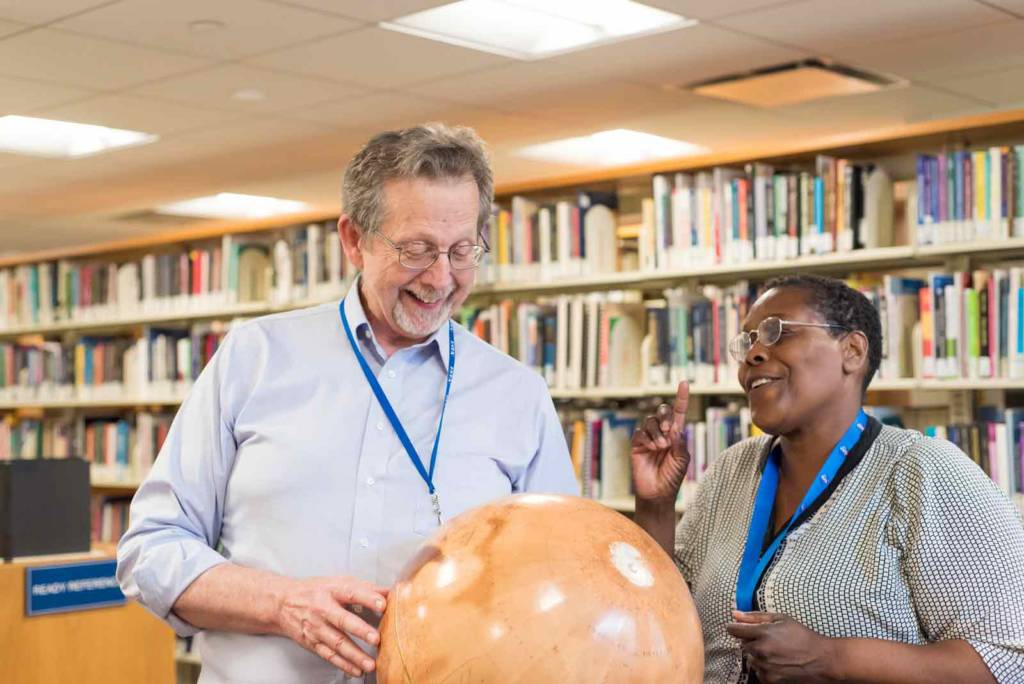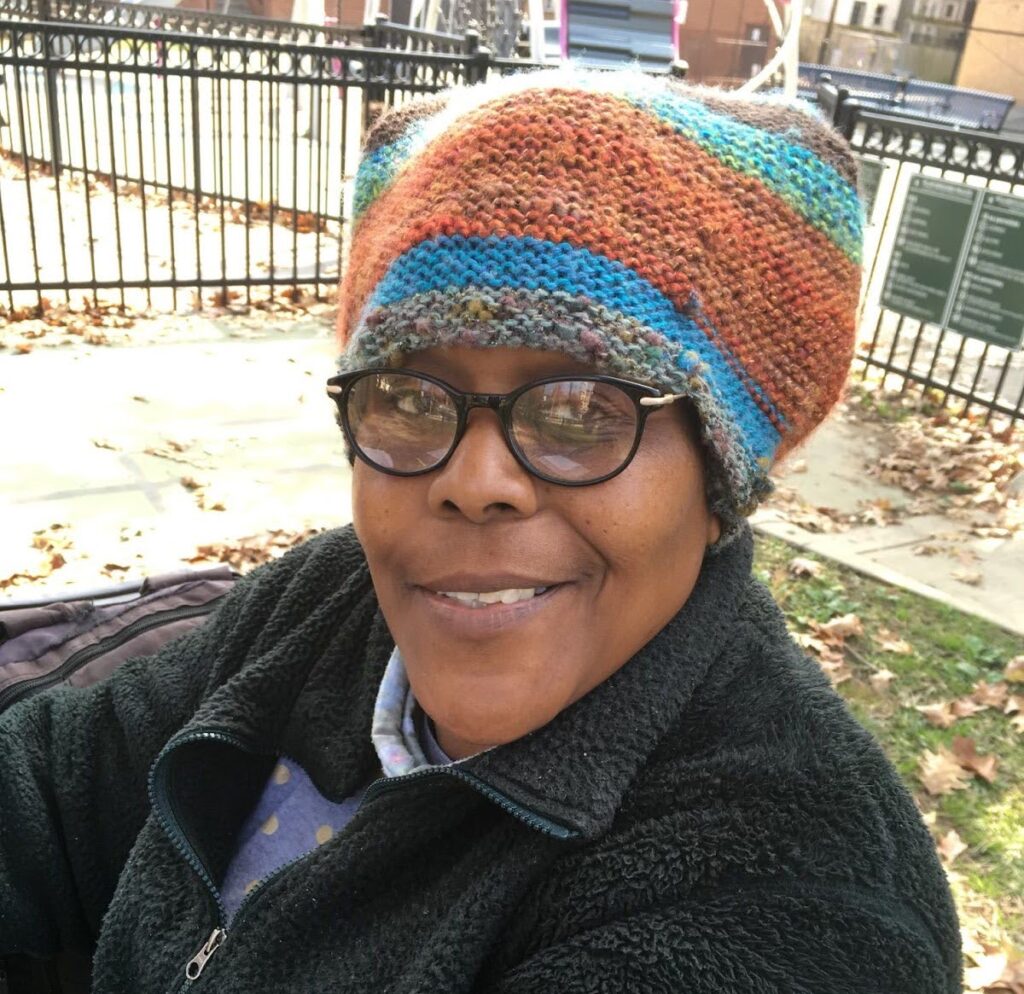Dr. Jim Green is director of the planetary science division for the National Aeronautics and Space Administration. He’s been with NASA for 37 years and refuses to retire until the question “Are we alone in the universe?” is answered. Green has had some type of role with the exploration of every planet in our solar system and was involved with the CASSINI spacecraft that was purposefully plunged into Saturn earlier this year, having orbited the planet to collect data since 2004.
That’s the mission that Cynthia Mewborn, a Street Sense Media vendor, was excited to ask about when she saw someone in a NASA shirt pass her while she was selling the newspaper. “Hey, NASA man!” she called several times. Green was having a conversation but he turned around. “When you said, ‘what do you know about CASSINI?’ you had me,” Green later admitted. “We could have talked as long as you wanted.” He provided his business card and agreed to an interview with Mewborn in the library at NASA headquarters in Southwest D.C.
Street Sense: Without Earth, we would all be homeless. How is climate change affecting our environment and what are our options for life elsewhere?
Jim Green: Okay, you’re asking a planetary scientist. [We] take the long view. This Earth was created 4.5 billion years ago.
It was created?
Green: Yeah, so material came together from a big collapsing cloud. The sun started. The planets interacted. We started with an atmosphere, we got hit by another big object — that created the Earth and the Moon. Then everything settled down. We got a bigger atmosphere. And then we were on our own for a little while.
And what we found, was that the climate of the Earth, the atmosphere, did nothing but change. It changes all the time. So it’s not so much about, “It’s changing.” It’s about how fast it’s changing. And it changes for a whole variety of reasons.
So the concepts are that we figure out what’s happening and then figure out either how to live with it, how to go live somewhere else, or how to modify our climate.
Now, we’re not at the point where we modify our climate. We don’t know enough about that, yet, I think, to just modify our climate.
Could you be a little more specific?
Green: If we could wave a wand and stop Hurricane Maria from the devastation that was going on — we’d have done it. Spending a billion dollars stopping it when it generates billions and billions of dollars in damage is worth it. But we don’t have the ability to do that. And that may happen in the future. I think we’re smart enough as a human race to do that, in the long run.
We’ve got a lot of research to do. And NASA does a lot of that research. [We have] a lot of great Earth science satellites. For example, The Weather Channel talks about the weather all the time and shows these great views. Where do you think they get that data? The Weather Channel doesn’t have any satellites. They get it from us! (laughter)
From a planetary perspective, our next steps indeed are starting a program with our astronauts going beyond low-Earth orbit and out into space. The moon is a great object, but Mars is even better because it has an atmosphere and an environment much more like ours than anything else. We know a lot about it, from this guy in particular (gestures to a model of the Curiosity rover).
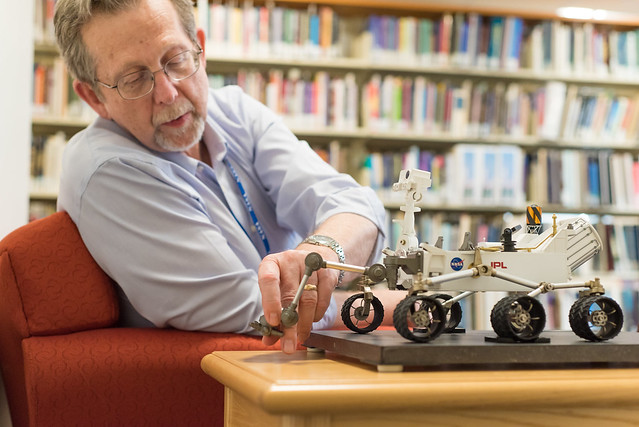
This is one of my missions. It’s a huge rover. If I stood up, the camera lenses would be like this (points to his own eyes). But they’re above my height. All the images they take, they take in stereo — as if there’s a human standing on the surface. What they do is they recreate the environment so that you can actually walk around in it.
No way! You mean virtual reality?
Green: Yeah — we can do that! [And] in here (points to model rover) are a bunch of science experiments. It makes all kinds of measurements, spins around, drills holes and then scoops up material, comes around here and puts it in these ports. It tastes the soil—
It “tastes?”
Green: Yeah! So what I mean by that is when you eat something, you get the flavors, right? This tastes like almond, this tastes like salt, this tastes like garlic — right? Well, that’s what this does. Except this tastes chemicals. [Mars has] carbon, hydrogen, oxygen, nitrogen, it has phosphorous and sulfur. It’s got all the great elements for life. Those are the chemicals that are in our bodies. And it’s got nitrates in the soil and the soils are moist — we can grow food in it. Can’t do that on the Moon, you can do that on Mars but you can’t do that on the Moon.
So that’s why Mars is so critical?
Green: Yeah! Mars is an atmosphere, a place, that we could live and work. You’d have to take a breathing system because it doesn’t have a lot of oxygen that you can breathe. It’s about 90 percent carbon dioxide. You’re still going to [need] some sort of suit. You won’t need the big puffy suit. But you’re going to need oxygen. And all our citizens are behind the program, paying taxes, allowing us to do this great stuff. So what [else] do we learn?
One thing I think is particularly interesting is that they want to take materials off asteroids. They also want to build some sort of shield. EDITOR’S NOTE: NEOShield is an international effort promising threat-reduction techniques to prevent the impact of near-Earth objects such as asteroids.
Green: Right! They want to mine them. Because there’s iron material, there’s aluminum, there’s titanium. There’s all kinds of stuff in asteroids.
But [Mars] has a very thin atmosphere, meteors of almost any size make it through. Here on Earth, if you had something about the size of this room — 10 or 20 meters in size, about a tenth of a football field, which sounds pretty big — that won’t make it to the ground. Our atmosphere will burn it up, it’ll never make it to the ground. Our atmosphere really helps us. It takes something really big to make it through, but when it makes it through, it’s going to give us a wallop. So we are on the lookout for things that could really hit the Earth. Y’know, the dinosaurs didn’t have a space program. (laughter)
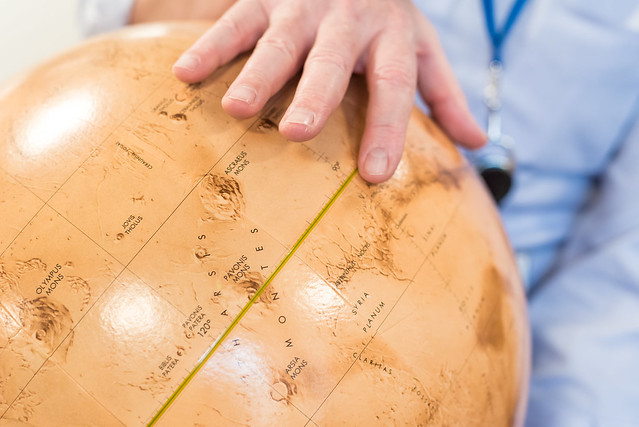
You’ve said your goal is to not retire until the question “Are we alone in the universe?” is answered. How likely do you think it is we’ll find evidence of life elsewhere?
Green: Every day I come to work I see we’re getting closer to answering that question. When we go out to planets and we’re looking for liquid water, that is an area where life could have existed. And we’re finding it all over the place. It’s everywhere. In fact, it’s in regions where we never thought it would be possible to have water. Ice doesn’t help us, it’s got to be the liquid. Temperature and atmospheric pressure need to be right too. If you don’t have enough pressure, you can’t keep the hydrogen molecules together to form water, so that’s critical too.
Might this happen in upcoming Mars missions? One of your orbiters found evidence that water currently flows on Mars. What could the 2018 ”InSight” mission tell us?
Green: InSight is all about how active this planet is. InSight has the most sensitive seismic instruments we’ve ever made on this Earth. It’s a lander, it doesn’t rove around. It plops these instruments down on the ground so it can just feel everything. And then we use that to determine what’s inside the planet and how active the planet is.
Now, that’s important if humans are going to be there. If that planet shakes all the time, you’ve got to construct things that are going to survive. So that’s important for human exploration of Mars.
We’ve observed avalanches [on Mars] from space. So when we’ve got our orbiters and they go over and they’re taking pictures, taking pictures, taking pictures — and right there, there’s an active avalanche going on that we just happen to catch. We’ve actually caught several of them. So we know that that planet is shaking. What we don’t know is what it’s like on the inside and whether all that shaking is due to the fact that there’s magma moving around or is it shaking because of the impacts. Because it still creates new craters. It still has meteorites coming in and hitting it.
How did you get interested in studying the planets?
Green: To do the kind of things we do, we need what I call a “gravity assist.” When [NASA goes] from place to place in the solar system, we have huge planets we fly around. They fling us places. In life, it’s very much like that, you need a mentor. You need somebody that gets you excited, somebody that tells you “look at this new and neat stuff” and “don’t you want to study that more.”

My first gravity assist happened in high school. I had a chemistry teacher who ended up being the head of an observatory. I took an astronomy course from him and ended up working in the observatory. By the end of high school, I knew exactly what I wanted to do. I already was good in math, I already was good in science and I was good in history, I loved history. So I had a choice at that time: Do I want to be a historian or a history teacher or a lawyer? There’s a number of jobs in which [history] aids students to create professions. But my brother told me, “y’know, why don’t you stay in science?” And as soon as I got working in the observatory, that was it. I wanted to do that.
EDITOR’S NOTE: Green still loves history. He researches the Civil War in his spare time and is working on several book projects.
When I went to the University of Iowa, I had other gravity assists by teachers that were there — getting me more and more interested in studying planets from spacecraft.
Y’know, when I was born, we didn’t have a space program. I was young when Sputnik came over, and I really didn’t pay much attention to it at the time. This [year] is the 60th anniversary since the Russians put something up. (October 4, 1957) At the time, everything we knew about the planets we got from the back end of a telescope. Now, we’ve been to every major planet — all the way out to Pluto! Mercury, Venus, we orbit Earth all the time, Mars, Jupiter, Saturn, Uranus, Neptune and Pluto. And the United States has gone there first.
And you’ve been a part of it?
Green: Pretty much so. Every one of them. I’ve been involved in the data analysis, or understanding what they’re doing and how it relates to what I do. One of the things that we’ve been doing is making all of our data available. We want to tell people.
Would you ever consider being a mentor?
Green: I have been a mentor my whole career. [For example, I worked with] a fabulous group of high school students one summer from the D.C. schools. I said, “We’re going to do science in a very unusual way. We’re going to go to the Library of Congress and we’re going to read newspapers, we’re going to read old newspapers, we’re going to read newspapers that are 150 years old.” The Library of Congress has the greatest collection of newspapers around.
Was there a science section?
Green: No, we were going right to the front page. What happened, was in 1859, there was an enormous aurora. It started up north and rolled right over the states — all of the states — and it rolled right over Mexico, right over Cuba and down into Central America. It’s called a “superstorm.”
And the newspaper was telling us all kinds of things about that superstorm. We went down to the [Library of Congress] every day for several weeks, reading newspapers and taking notes. We put a database together about where the observations were and at what time. Then I put together a model to determine what was happening all around the Earth and to determine what was happening between us and the sun. Just from the aurora, because we know how to do that now. These kind of storms are important to study because the technologies we have today are vulnerable to them. What happens is particles rain on our upper atmosphere. A current is generated in our atmosphere, and that’s what you have to watch out for. If you have a laptop and that current rolls over you, it can interfere with your laptop and burn out your circuits. When I say superstorm, I mean it would take out generators and lights everywhere. The current that occurs in the ionosphere interacts with all circuits that are on the ground.
We were studying that storm to determine how often they occur. And we found out that one of the key characteristics of that storm was a red aurora. Here in the United States, it was like the sky was blazing red as it moved across. So we went further back into historical records looking for red aurorae. We went into Chinese records and Japanese records over about 1,500 years and we found about ten of them. That means that every 150-200 years, we ought to expect one of these geomagnetic superstorms.
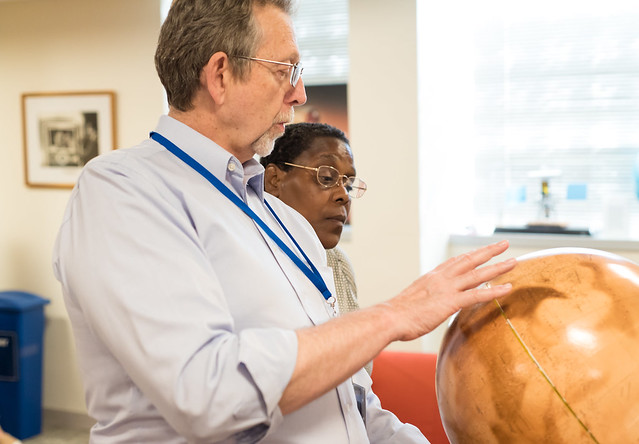
That’s interesting, especially when you think about that solar flare that we had recently. An aurora, that’s plasma right?
Green: That’s where it comes from. This hot gas gets accelerated, comes in and gets pushed down into our atmosphere. It hits our atmosphere and gets things excited, which emits light. It’s like this light right here (gestures to a lamp): you turn on the electricity and all that is a gas that emits light because you are stimulating it.
You’ve said math and science are important for people interested in your field, “but being determined to be successful is at least half of it.” How much do you think that applies to other careers or other aspects of life?
Green: I think that the critical thing is getting excited about a particular area and getting immersed and learning about it and being determined. From high school to a Ph.D. is an incredibly long process. That’s ten years of courses, study, and tests — some you fail, some you get A’s. But you know, when you fail, you don’t quit. You keep going. And that’s the only way you make it to the end. It’s that determination. That’s what we want to instill in our kids: never to give up. It’s like that movie (Galaxy Quest): “never give up, never surrender.”
So, speaking of never giving up: How did you sustain yourself while going to college? Have you personally experienced poverty?
Green: That’s a really good question. So my dad was killed in an airplane accident when I was in high school. And my mom never remarried. She had a job as a telephone operator. We didn’t even have enough money for me to go and get a high school senior picture. I knew that, and I didn’t bug her about it, and that came and went. You can pick up our yearbook and look in there for a senior picture of me and you won’t find one.
So, I decided that I was going to the University of Iowa because, within that state, that school was the cheapest I could go to. My mom worked hard. And during the summer, I worked as a roofer. I worked really hard and made enough money to keep going each and every year. So I was living sort of paycheck-to-paycheck. I’d make a paycheck and spend it on books, tuition and the dorm room that I was in. And there were nights I didn’t have enough money to eat. Workin’ hard roofin’ houses was also really important to me [because] I was working with guys that were 45 years old, and to me that was ancient. And I kept thinking “I’m not gonna end up doing that all my life.” So, it also helped me — it was another gravity assist — to realize that if I stayed in school, I could have a better future. I was motivated and I was good at it. So I just followed that dream as hard as I could.
And, y’know, that’s just me. There are many roads that people take.
This interview has been edited and condensed.

